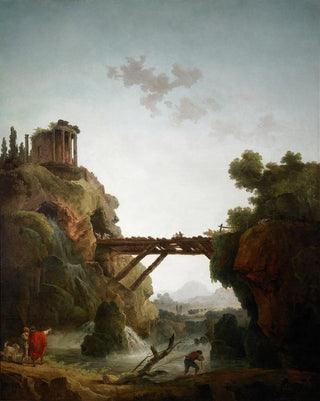Art print | Fantastic view of Tivoli - Hubert Robert


View from behind

Frame (optional)
Heart of Italy, the city of Tivoli stands as a jewel of beauty, inspiring numerous artists throughout the centuries. Among them, Hubert Robert, an 18th-century painter, masterfully captured the very essence of this enchanting place in his iconic artwork "Fantastic View of Tivoli." This painting, imbued with romanticism and dreaminess, invites viewers to escape into a world where nature and architecture intertwine harmoniously. The delicate light bathing the landscape, along with the majestic ruins, makes this piece a true visual poem—a tribute to the magnificence of nature and human creativity.
Style and uniqueness of the artwork
The "Fantastic View of Tivoli" is distinguished by its unique style, characterized by a subtle blend of realism and imagination. Hubert Robert, often nicknamed the "painter of ruins," excels in depicting landscapes where man and nature coexist in perfect harmony. The warm, golden hues of the canvas evoke an atmosphere of serenity and contemplation. The ancient ruins, bathed in soft light, seem to tell the story of a glorious past, while the lush vegetation surrounding them testifies to the power of nature. Every detail, from delicately painted leaves to the play of shadow and light, contributes to creating a balanced and dynamic composition. The artwork thus transports the viewer into a waking dream, where they can admire the timeless beauty of Tivoli.
The artist and his influence
Hubert Robert, born in 1733 in Paris, established himself as one of the masters of 18th-century landscape painting. Trained at the Royal Academy of Painting and Sculpture, he developed a style that combines academic rigor with poetic sensitivity. His work is not limited to simple landscape depiction; it also evokes reflections on the passage of time and the fragility of existence. Robert had a significant influence on his contemporaries and paved the way for artists such as Claude Lorrain and Nicolas Poussin. His innovative approach to landscape inspired many artistic movements,

Matte finish

View from behind

Frame (optional)
Heart of Italy, the city of Tivoli stands as a jewel of beauty, inspiring numerous artists throughout the centuries. Among them, Hubert Robert, an 18th-century painter, masterfully captured the very essence of this enchanting place in his iconic artwork "Fantastic View of Tivoli." This painting, imbued with romanticism and dreaminess, invites viewers to escape into a world where nature and architecture intertwine harmoniously. The delicate light bathing the landscape, along with the majestic ruins, makes this piece a true visual poem—a tribute to the magnificence of nature and human creativity.
Style and uniqueness of the artwork
The "Fantastic View of Tivoli" is distinguished by its unique style, characterized by a subtle blend of realism and imagination. Hubert Robert, often nicknamed the "painter of ruins," excels in depicting landscapes where man and nature coexist in perfect harmony. The warm, golden hues of the canvas evoke an atmosphere of serenity and contemplation. The ancient ruins, bathed in soft light, seem to tell the story of a glorious past, while the lush vegetation surrounding them testifies to the power of nature. Every detail, from delicately painted leaves to the play of shadow and light, contributes to creating a balanced and dynamic composition. The artwork thus transports the viewer into a waking dream, where they can admire the timeless beauty of Tivoli.
The artist and his influence
Hubert Robert, born in 1733 in Paris, established himself as one of the masters of 18th-century landscape painting. Trained at the Royal Academy of Painting and Sculpture, he developed a style that combines academic rigor with poetic sensitivity. His work is not limited to simple landscape depiction; it also evokes reflections on the passage of time and the fragility of existence. Robert had a significant influence on his contemporaries and paved the way for artists such as Claude Lorrain and Nicolas Poussin. His innovative approach to landscape inspired many artistic movements,






